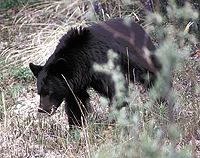In recent years, residents living up and down Ketchum's Warm Springs neighborhoods have had a roving, seasonal neighbor, albeit one of the furry, four-footed and Dumpster-diving sort.
Unlike many of their more visible neighbors, this one is largely nocturnal and seems especially adept at tipping over trashcans. Ripped-open trash bags attest to the real purpose behind this hungry prowler's nighttime wanderings.
Fortunately, the activities of this solitary intruder, actually a single, large black bear to be exact, usually come to an end by mid-fall as the call of winter hibernation beckons.
The same bear's apparent reappearance each summer has become so expected for neighbors living in the lower Warm Springs Creek area that they've actually quit notifying the Ketchum Police Department of most of his nighttime pranks, said the department's public information officer, Kim Rogers.
"Everybody knows he's there," Rogers said.
A combination of declining food sources and a pressing need to put on as much weight as possible occasionally causes bears to pursue easier sources of food during the fall, said Lee Garwood, a Fish and Game conservation officer who's based in the Wood River Valley.
This includes garbage left out by homeowners, Garwood said.
"All these bears are kind of pre-denning. They're trying to put on as much weight as possible," he said.
Although the Warm Springs bear has been making semi-regular appearances throughout the summer and fall, the Wood River Valley has actually seen fewer urban bear visits this year compared to previous years, Garwood said. This may be related to a banner crop of chokecherries in the area this year.
"The bears pull out and utilize that," Garwood explained.
Still, homeowners shouldn't let down their guard so easily.
To discourage unwanted interactions between people, bears and other wildlife, Fish and Game recommends that Wood River Valley residents:
- Delay placing trashcans out at the curb until the morning of trash pickup.
- Place trashcans inside garages or other secure locations when they're not in use.
- Close garage doors to keep wild animals away from trash.
- Bring pet bowls and pet food inside once pets have been fed.
- Limit the use of bird feed, which can attract wildlife such as bears in the fall.
- Report all bear sightings in populated areas to the local office of the Idaho Department of Fish and Game. The agency's regional office in Jerome can be reached at (208) 324-4359.
Black bears aren't the only species of Wood River Valley wildlife that local residents need to be cautious around in the fall, Garwood said.
Moose, whose rutting or mating season roughly coincides with the turning of the leaves, also should be given a healthy dose of respect. The large ungulates are most often seen along river corridors, which can often place them in close contact with people, Garwood said.
Anglers who find moose at their favorite fishing holes should find another spot to fish that day.
"There's other places to go," Garwood said.
Moose will often view domestic dogs as a threat and will turn on them, he said. When this happens, hikers should immediately remove themselves from the situation and let the pet fend for itself, Garwood said.
"You need to let the dog be on its own for a minute," he said.
Beginning in the fall, people should also expect increasing numbers of wildlife—especially deer and elk—near roadsides and in more populated areas, Garwood said.
Despite the attraction of seeing wildlife up close, Fish and Game asks people not to feed them. Wild animals simply don't need additional sources of food from people and can survive just fine on natural foods, Garwood said.
Habituating wildlife to human food takes away their wildness and can bring them into closer and often detrimental contact with people, he said.
"Respect wildlife," Garwood said. "View them from a distance."


 A black bear makes its way through grasslands. The Idaho Department of Fish and Game is advising local residents to take extra precautions this fall to prevent unwanted interactions with black bears and other wildlife species. Express file photo.
A black bear makes its way through grasslands. The Idaho Department of Fish and Game is advising local residents to take extra precautions this fall to prevent unwanted interactions with black bears and other wildlife species. Express file photo.



































